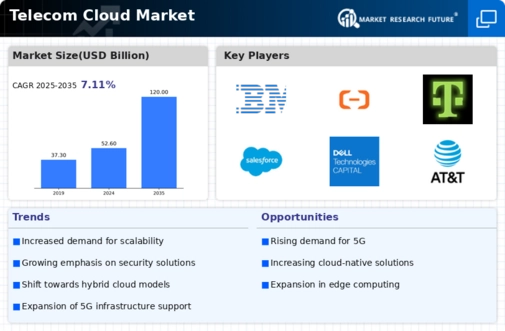Top Industry Leaders in the Telecom Cloud Market

The Competitive Landscape of the Telecom Cloud Market: Navigating a Booming Sector
The telecom cloud market, encompassing cloud-based solutions for network functions and telecommunications services, is experiencing explosive growth, projected to reach a staggering Value in billion by 2028. This rapid expansion has attracted a diverse range of players, each jockeying for position in this lucrative landscape.
Key Players:
- AT&T Inc
- BT Group PLC
- Telefonaktiebolaget LM Ericsson
- Verizon Communications Inc.
- Telstra Corporation Ltd.
- Fortinet
- Orange
- Huawei Technologies Co., Ltd.
- VMWare
- Cisco
- Nokia
- Ericsson
Strategies for Success:
-
Product Portfolio Diversification: Players are expanding beyond core infrastructure to offer managed services, analytics, and AI-powered solutions, creating one-stop-shop experiences for telcos.
-
Partnerships and Collaborations: Strategic partnerships are commonplace, enabling cross-pollination of expertise and market reach. For example, cloud providers might partner with established telcos to access enterprise clientele, while telcos may partner with software vendors to customize solutions for specific network needs.
-
Openness and Interoperability: Recognizing the dynamic nature of the market, players are embracing open standards and interoperable platforms to ensure flexibility and avoid vendor lock-in for telcos.
-
Investment in R&D: Continuous innovation is key, with players actively investing in cloud-native technologies, 5G network slicing, edge computing, and automation solutions to offer advanced capabilities and meet evolving telco requirements.
Factors for Market Share Analysis:
-
Geographic Focus: The market dynamics vary across regions, with mature markets like North America demanding advanced, integrated solutions, while emerging markets may prioritize cost-effective options.
-
Technology Expertise: Players' capabilities in areas like network virtualization, software-defined networking, and containerization significantly impact their competitiveness.
-
Customer Base and Brand Recognition: Established telcos and cloud providers have inherent advantages due to existing relationships and brand awareness, though agile start-ups can win through niche offerings and rapid innovation.
-
Pricing and Financial Flexibility: Competitive pricing models, subscription services, and attractive financing options are crucial for attracting cost-conscious telcos, especially in emerging markets.
New and Emerging Companies:
The influx of new entrants, primarily start-ups, is a defining feature of this market. These companies are often highly specialized, targeting specific network functions or addressing niche telco needs with innovative solutions. Examples include:
-
Affirmed Networks: Offering 5G cloud-native core solutions with disaggregated architecture and open interfaces.
-
Mavenir: Providing open RAN and cloud-native network orchestration solutions for mobile networks.
-
Ciena: Focusing on edge computing and automation solutions for fiber optic networks, particularly relevant for 5G backhaul.
Current Investment Trends:
Investment in the telecom cloud market is robust, with both established players and venture capitalists pouring in funds. Key areas of focus include:
-
Cloud-native platforms: Enabling flexible and scalable telecom network functions.
-
5G network solutions: Capitalizing on the massive 5G network rollout globally.
-
AI and machine learning: Integrating intelligence for network optimization and automation.
-
Edge computing: Addressing the ever-increasing data processing needs closer to the network edge.
Latest Company Updates:
-
Dec 28, 2023: Juniper Research: Global public cloud spending by telcos to reach $84 billion by 2025, with 5G and edge computing driving growth. -
Jan 4, 2024: Telecom Review: Industry report highlights challenges hindering wider telecom cloud adoption, including security concerns, lack of skilled personnel, and interoperability issues. -
Dec 19, 2023: T-Mobile US: Selects Google Cloud as strategic partner for 5G network transformation and cloud-native infrastructure.

